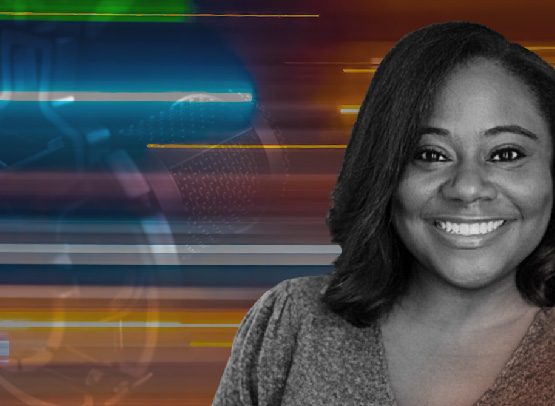Pain is a bad word in many organizations. Unspoken, “pain” is too real, too negative, too far from the corporate positivity that tends to define modern communication. But ignoring pain – the idea that we feel it, that it burdens us, that we are, perhaps, always struggling with some kind of pain in our jobs – can yield some of the most frustratingly out-of-touch communication. Because communication without an understanding of pain is more than just inauthentic. It is communication without care.
Judy Corupe does not shy away from pain in her work. The VP of Creative at Livewire, Judy has spent more than 20 years of her career refining the art of listening to pain and using it to create connection. Thanks to her background in advertising, her work in change communication is distinctively arresting. Her grasp of light and shadow and color and sound has the power to pique an audience’s interest so that they’re ignited with a sense of “Oh, what’s this?” right before they pull up a chair, settle in, and feel the work resonate as though it were speaking to them, and them alone.
What is at the core of this rare resonance? Judy sits down with us to discuss how her work fits into the communication triad of creative, strategy, and activation. It is a conversation that spirals and splits into a thousand pieces. But there are questions we keep returning to: How can communicators get attention in a world overloaded with distractions? And how do we build trust from an understanding of pain?
Judy dresses in all black – a color she wears exclusively so that her choice of clothing doesn’t intrude on the hundreds of creative choices she must make in a day. Her personal and professional creativity is “a separation of church and state,” as she puts it. Judy has none of her own art around her, as seeing her own work plunges her right back to the moment she created it – down to the room, its smell, the food she was eating, and even the painful heartbreaks at the time – memory trips too visceral to deal with daily. Her office is necessarily bare.
She sits relaxed, contemplative of the role of creative in change communication. As she responds to us, she looks up or sideways, admitting she sees visual concepts everywhere, literally, a kind of second sight that she has honed all her life.
We start with pain. We keep returning to it.
Building a foundation from pain
“Pain” is not the same as “pain points,” a term that Judy believes is too often thrown around but that doesn’t get at the actual lived, emotional experience of frustration and struggle with one’s job. Pain at work may not be just a pain point, but rather a pain mass, a force corrupting an entire experience.
It’s pain that has the power to cut through all the information people are overwhelmed by every day. And it’s understanding pain that paves the way to communications of care, a practice that recognizes the fundamental humanity of your audience and works to foster belonging and trust with them.
“If I know that somebody is struggling with something in their work,” Judy says, “I call that out right away: ‘We know this part of your job causes you pain, and we know how to fix it.’ Chances are they’re thinking: ‘Everything in my job takes so long, there’s so much red tape, there are so many levels I have to go through. Things could be so much simpler.’”
Indeed, the workforce desperately needs this simplicity; employees everywhere feel undervalued and overloaded with digital minutiae. And though some organizations would see this as a pain point to be addressed with a quick campaign, Judy would see being overloaded to the point of job and career detachment as a literal, unbearable weight that people suffer with and feel in all dimensions of their lives.
But creatives can go far with this distress. They have the power to listen, to intimately understand and process their audience’s pain, and then transform this pain to a feeling critical to the purpose at hand: inspiration, opportunity, and even hope.
The key to this transformation – from pain to all its potentialities – hinges on creative’s power to turn lonely pain into communal struggle, thereby telling a story of opportunity that connects one to many and that grounds complex change in recognizable human experiences.
She recalls a real-world example. A client required frontline employees to buy into a new digital platform – a potentially clunky communication initiative that would, perhaps, traditionally be done via a two-page email with an eight-page PDF attached. An intimidating, anxiety-inducing document like that would never get read but would overload the workforce with the dread that another new, important technology is coming and you have to learn it. Or else.
Instead, Judy opted to teach choreography.
She took a group of real employees (who had no idea what they were being filmed for) and brought in a choreographer to teach them a dance. People struggled with the steps, worrying about looking foolish in front of their coworkers. But as they learned with one another, improving little by little, a community began to form. The relationship between the new choreography and the new digital platform was becoming clear: Yes, a new technology is coming, but it’ll feel exactly like this. We’ll struggle with it together, but eventually we’ll come away better.
Given final form as a three-minute, documentary-style video that followed the participants, with the final act a joyous flash mob erupting in the workplace, Judy transformed the shapeless unknowns of the coming change into the nervous but ultimately triumphant experiences of the workforce. For thousands of employees, she gave an emotional shape to the change journey, which braced them for the new technology ahead.
How Judy gets from digital adoption to choreography documentary is through pain: symbolizing change and giving the pain a story arc. “In defining the problem,” she says, “there’s a craft to articulating the pain and how it relates to the organization. Find what people are looking for, what they need, and start there.”
In other words, creatives can build a foundation of trust to create meaningful communication that is both compassionate to their audience’s specific needs and refreshingly authentic. Step 1, however, is always an understanding of pain.
This demand for authenticity in communication, the need to listen to pain, and the conviction to tell the truth are all intertwined. As Judy puts it, “Just like in the world of advertising, you know you’ve nailed it when you’ve found the truth. You want people to feel ‘You’ve heard me, you’re listening.’”
Only then can hope feel achievable, grounded, and real.
Communicating against overload
Understanding pain is the first step to creating communications of care. But in articulating pain, Judy reminds us, “When you’re making things like videos or writing a script, you need to know when to stop. There is a discipline involved in that. Communicators can get caught up in the moment.”
Her favorite proverb is “Less is more, space is grace.” She keeps referencing these words, as though they’re engraved somewhere on her desk.
“It is much harder to say five impactful words than it is to say 15. From writing and verbal communication to design, there is an art and a craft to simplification.”
I ask, “How do you know when to stop communicating?”
“You know when to stop when you start to become mired in information. It’s like eating candy: a little is good, but then you become so full you don’t want any more.”
Too much candy feels especially true, given that work today is defined by digital overload and burnout. This sense of overload has been characterized as the “dark matter of work,” a fitting metaphor for the heavy, cumbersome, and pervasive parts of our job that remain dangerously invisible.
The takeaway? Leaders and communicators should prioritize thoughtfulness and intention, not urgency.
As Judy reminds us, “There are so many simpler ways to inspire. You can inspire someone with a black canvas and a white dot.”
Instilling care in communication
Judy’s principle of recognizing pain to build trust strikes me as the wisdom gained from active listening and creating psychological safety. People feel most listened to when you take in, process, and express their pain for them – either for the first time or in a way they’ve never heard before. Listening to and understanding pain has the power to create the space for authentic communication, which feels as grounding and as necessary as a deep breath.
One of the most powerful investments leaders can make is in tools and technologies to understand their workforce, thereby gleaning something crucial and specific about what their pain is – and using this knowledge to care for and connect with them.
I ask her: “What are some universal ways to build a connection with people?”
She replies: “People love to laugh. They love to see something that moves them. They have emotional connections to music. Sound can change emotions right away – it can be disarming, arresting, energizing. And, of course, there’s simplicity.”
There’s her favorite proverb again: Less is more. She adds to it: “Give us space to breathe. Information has to come in chunks and bite-size pieces. Say what you mean and mean what you say. And let it settle.”
Pain is a good word
To wrap up our discussion, I ask Judy what her next art project is.
But with 20+ years of creating videos, ads, and illustrations, overseeing a team of creative directors, designers, art directors, and writers in her day-to-day role, and completing the development of all creative deliverables for hundreds of projects, she doesn’t consider herself an artist.
She feels she puts a lot of passion into her work, but this is different from creating art. Art is for herself; creative is for others.
“If I was truly creating art for myself, I would be less critical. But because I’m creating communications for other people, I’m highly critical. I want it to be right for them.”
She adds, “For true art, you give up a piece of yourself.”
In other words, art is pain. Communication is too. In all parts of the process, there will be pain in getting the message right, in addressing other people’s struggles, and in confronting our own flaws.
But despite many organizations’ avoidance of the word, pain needs to be said more: it’s a concept of opportunity, holding deep reservoirs of insight and an ecosystem of new connections that can create communications of care. Pain is the beginning of change. Understanding it is the basis for evolution, opportunity, inspiration. And, as Judy would remind us, hope.







